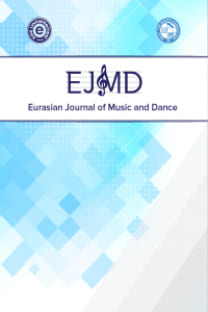SESTEN NOTAYA: SÛZİNÂK İLÂHÎ, “AŞKIN İLE ÂŞIKLAR” ÖRNEĞİ
Bestecilik, edisyon kritik, ilâhî, usûl, Yunus Emre
From Sound to Music Sheet: SûzinâkHymn, “Aşkın ile Âşıklar”Exampl
Composition, edition critic, hymn, usûl, Yunus Emre,
___
- Albayrak, Nurettin (2002). TDV İslam Ansiklopedisi. Ankara: TDV Yayınları. C.26, S. 226-227.
- Akdoğu, Onur (1995). Türk Müziği’nde Türler ve Biçimler. İzmir: Can Ofset.
- Ayas, Güneş (2014). Mûsikî İnkılâbı’nın Sosyolojisi. İstanbul: Doğu Kitabevi.
- Cevher, Hakan (1993). Rehber-i Mûsıkî. İzmir: Ege Üniversitesi Basımevi.
- Çırak, Cem (2015). “Hacı Ârif Bey'in Kürdîli Hicazkâr Makamındaki Eserleri Çerçevesinde Besteciliği”. Yayımlanmamış yüksek lisans tezi. İzmir: Ege Üniversitesi.
- Karadeniz, Ekrem (ty). Türk Mûsıkîsinin Nazariye ve Esasları. Ankara: Türkiye İş Bankası Kültür Yayınları.
- Kaygusuz, Nermin (2014). “19. Yüzyıldan 21. Yüzyıla Türk Müziğinin Kısa Bir Hikâyesi”. Yeni Türkiye. S.57: 1464-1471.
- Özkan, İsmail Hakkı (2013). Türk Mûsıkîsi Nazariyâtı ve Kudüm Velveleleri. İstanbul: Ötüken Neşriyat.
- Öztuna, Yılmaz (2006). Türk Mûsıkîsi. Ankara: Orient Yayınları. C.1.
- Popescu-Judetz, Eugenia (2007). Türk Mûsıkî Kültürünün Anlamları. Çev. Bülent Aksoy.
- Sûzinâk İlahi1 http://www.sanatmuziginotalari.com/nota_inderme.asp?notaid=63080&mode=1&sessionid= 323101182 Erişim Tarihi: 30.05.2018
- Sûzinâk İlahi 2 http://www.sanatmuziginotalari.com/nota_inderme.asp?notaid=23752&mode=2&sessionid=3231 01182 Erişim Tarihi: 30.05.2018
- Sûzinâk İlahi 3 http://www.sanatmuziginotalari.com/nota_inderme.asp?notaid=21815&mode=2&sessionid=3231 01182 Erişim Tarihi: 30.05.2018
- Sûzinâk İlahi 4 http://www.sanatmuziginotalari.com/nota_inderme.asp?notaid=18378&mode=2&sessionid= 323101182 Erişim Tarihi: 30.05.2018
- Sûzinâk İlahi 5 http://www.sanatmuziginotalari.com/nota_inderme.asp?notaid=11679&mode=2&sessionid= 323101182 Erişim Tarihi: 30.05.2018
- Tanrıkorur, Cinuçen (2011). Osmanlı Dönemi Türk Mûsıkîsi. İstanbul: Dergah Yayınları.
- Yektâ, Râuf (1986). Türk Mûsıkîsi. Çev. Orhan Nasuhioğlu. İstanbul: Pan Yayıncılık.
- ISSN: 2651-4818
- Yayın Aralığı: Yılda 2 Sayı
- Başlangıç: 2011
- Yayıncı: Ege Üniversitesi
SESTEN NOTAYA: SÛZİNÂK İLÂHÎ, “AŞKIN İLE ÂŞIKLAR” ÖRNEĞİ
TÜRKİYE’DE MODERNLEŞME SÜRECİNİN MÜZİĞE YANSIMALARI BAĞLAMINDA “KLASİK KORO” ÖRNEĞİ
İZMİR’DEKİ TÜRK SANAT MÜZİĞİ AMATÖR KOROLARININ İNSAN YAŞAMINDAKİ YERİ
GELENEKSEL TÜRK SANAT MÜZİĞİNDE MAKAM GEÇKİLERİ
GİRESUN HALK OYUNLARI -Etnokoreolojik Bir Değerlendirme
VİDEO OYUN MÜZİKLERİNİN ÜNİVERSİTE ÖĞRENCİLERİNİN DAVRANIŞLARINA ETKİSİNİN İNCELENMESİ
Uğur BAKAN, Mücahit Yalçin ÖZTÜFEKÇİ
9/8 ROMAN DANSI Kültür, Kimlik, Dönüşüm ve Yeniden İnşa
